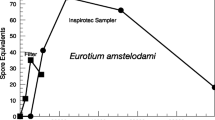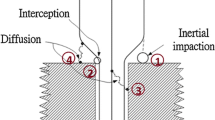Abstract
A sampler has been designed to collect particles in the nanometer and respirable sizes directly onto a membrane filter and transmission electron microscopy (TEM) grid. The novel design aspects of this sampler include the selection of the diameter of the inlet probe, geometry of the sampler, and the resulting air flow to the sampler. Together, they control the cutoff diameter, which was determined experimentally to be a mass median aerodynamic diameter (MMAD) of 3.8 μm. The maximum aerodynamic diameter entering the sampler is designed to be approximately 8 μm. Nanometer-sized particles are collected on both the filter and grid through diffusion, as confirmed by testing with aluminum oxide engineered nanoparticles collected on the filter which measured a count median diameter (CMD) of 500 nm and a geometric standard deviation (GSD) of 1.97. The primary particles and small agglomerates collected on the grid have a CMD of 100 nm and GSD of 2.3. This diffusion sampler collected close to, if not 100%, of the particles entering the sampler. The sampler is easily wearable for personal exposure and environmental sampling, operates at 0.3 L/min, and can collect particles in various settings at indoor and outdoor environments. Particles are analyzed directly by transmission electron microscope on the grid and by scanning electron microscope on the filter to assess the exposure through particle counts and elemental composition analysis.







Similar content being viewed by others
References
Almich BP, Carson GA (1974) Some effects of charging on 10-mm nylon cyclone performance. Am Ind Hyg Assoc J 35:603–612
Briant JK, Moss OR (1984) The influence of electrostatic charge on the performance of 10-mm nylon cyclones. Am Ind Hyg Assoc J 45(440):440–445
Cena L, Peters T (2011) Characterization and control of airborne particles emitted during production of epoxy/carbon nanotube nanocomposites. J Occup Environ Hyg 8:86–92
Cena LG, Anthony TR, Peters TM (2011) A personal nanoparticle respiratory deposition (NRD) sampler. Environ Sci Technol 45(15):6483–6490
Dahm MM, Evans DE, Schubauer-Berigan MK, Birch ME, Fernback JE (2012) Occupational exposure assessment in carbon nanotube and nanofiber primary and secondary manufacturers. Ann Occup Hyg 56(5):542–556
Fleischer T, Grunwald A (2007) Making nanotechnology developments sustainable. A role for technology assessment? J Clean Prod 16:889–898
Gorbunov B, Priest ND, Muir RB, Jackson PR, Gnewuch H (2009) A novel size-selective airborne particle size fractionating instrument for health risk evaluation. Ann Occup Hyg 53(3):225–237
Hinds WC (1999) Aerosol technology—properties, behavior, and measurement of airborne particles. Wiley-Interscience, New York
Johnson DR, Methner MM, Kennedy AJ, Steevens JA (2010) Potential for occupational exposure to engineered carbon-based nanomaterials in environmental laboratory studies. Environ Health Perspect 118(1):49–54
Kuhlbusch TAJ, Asbach C, Fissan H, Gohler D, Stintz M (2011) Nanoparticle exposure at nanotechnology workplaces: a review. Part Fibre Toxicol 8:1–18
Lee JH, Lee SB, Bae GN, Jeon KS, Yoon JU, Ji JH, Sung JH, Lee BG, Yang JS, Kim HY, Kang CS, Yu IJ (2010) Exposure assessment of carbon nanotube manufacturing workplaces. Inhal Toxicol 22:369–381
Leith D, Miller-Lionberg D, Casuccio G, Lersch T, Lentz H, Marchese A, Volckens J (2014) Development of a transfer function for a personal, Thermophoretic nanoparticle sampler. Aerosol Sci Technol 48(1):81–89
Lo LM, Dunn K, Hammond D, Marlow D, Topmiller J, Tsai S, Ellenbecker M, Huang C (2012) Evaluation of engineering controls in a manufacturing facility producing carbon nanotube-based products. National Institute for Occupational Safety and Health (NIOSH) Division of Applied Research and Technology Engineering and Physical Hazard Branch EPHB Report No. 356-13a
Maynard AD (2007) Weighing Nanotechnology's risks. Flying Blind, New York
Maynard A, Baron P, Foley M, Shvedova A, Kisin E, Castranova V (2004) Exposure to carbon nanotube material: aerosol release during the handling of unrefined single walled carbon nanotube material. J Toxic Environ Health A 67(1):87–107
Methner MM, Birch ME, Evans DE, Ku BK, Crouch K, Hoover MD (2007) Case study: identification and characterization of potential sources of worker exposure to carbon nanofibers during polymer composite laboratory operations. J Occup Environ Hyg 4(12):D125–D130
Methner M, Crawford C, Geraci C (2012) Evaluation of the potential airborne release of carbon nanofibers during the preparation, grinding, and cutting of epoxy-based nanocomposite material. J Occup Environ Hyg 9(5):308–318
Miller A, Frey G, King G, Sunderman C (2010) A handheld electrostatic precipitator for sampling airborne particles and nanoparticles. Aerosol Sci Technol 44(6):417–427
NIOSH (1994) Asbestos by TEM. Cincinnati, OH, Department of Health and Human Services, Centers for Disease Control and Prevention, National Institute for Occupational Safety and Health. NIOSH method 7402, issue 2
NIOSH (2008) Safe nanotechnology in the workplace. Cincinnati, Department of Health and Human Services, Centers for Disease Control and Prevention, National Institute for Occupational Safety and Health. NIOSH (DHHS) publication no, 2008-112
NIOSH (2009) Approaches to safe technology—managing the health and safety concerns associated with engineered nanomaterials. Cincinnati, OH, Department of Health and Human Services, Centers for Disease Control and Prevention, National Institute for Occupational Safety and Health. DHHS (NIOSH) publication no. 2009-125
NIOSH (2011) Occupational exposure to titanium dioxide. Cincinnati, Department of Health and Human Services, Centers for Disease Control and Prevention, National Institute for Occupational Safety and Health. DHHS (NIOSH) publication no. 2011-160
NIOSH (2013) Current intelligence bulletin 65—occupational exposure to carbon nanotubes and nanofibers. Cincinnati, Department of Health and Human Services, Centers for Disease Control and Prevention, National Institute for Occupational Safety and Health. DHHS (NIOSH) publication no. 2013-145
NSTC (2006) Environmental, health, and safety research needs for engineered nanoscale materials. Washington, D.C., National Science and technology council (NSTC), the National Nanotechnology Initiative, executive Office of the President of the United States
Oberdörster E (2004) Manufactured nanomaterials (fullerenes, C60) induce oxidative stress in the brain of juvenile largemouth bass. Environ Health Perspect 112(10):1058–1062
Park J, Kwak BK, Bae E, Lee J, Kim Y, Choi K, Yi J (2009) Characterization of exposure to silver nanoparticles in a manufacturing facility. J Nanopart Res 11(7):1705–1712
Roco MC (2003) Broader societal issues of nanotechnology. J Nanopart Res 5:181–189
Roco MC (2011) Erratum to: the long view of nanotechnology development: the National Nanotechnology Initiative at 10 years. J Nanopart Res 13:1335–1335
Schindelin J, Arganda-Carreras I, Frise E, Kaynig V, Longair M, Pietzsch T, Preibisch S, Rueden C, Saalfeld S, Schmid B (2012) Fiji: an open-source platform for biological-image analysis. Nat Methods 9(7):676–682
Schulte P, Geraci C, Zumwalde R, Hoover M, Castranova V, Kuempel E, Murashov V, Vainio H, Savolainen K (2008) Sharpening the focus on occupational safety and health in nanotechnology. Scand J Work Environ Health 34(6):407–409
Shvedova A, Castranova V, Kisin ER, Schwegler-Berry D, Murray AR, Gandelsman VZ, Maynard A, Baron P (2003) Exposure to carbon nanotube material: assessment of nanotube cytotoxicity using human keratinocyte cells. J Toxic Environ Health A 66:1909–1926
Sigma M (n.d.) GTTP02500 Isopore Membrane Filter. Jan. 2018
Simeonova PP, Opopol N, Luster MI (2007) Nanotechnology—toxicological issues and environmental safety. Springer, Dordrecht
Singh S, Nalwa HS (2007) Nanotechnology and health safety—toxicity and risk assessments of nanostructured materials on human health. J Nanosci Nanotechnol 7(9):3048–3070
Spurny K, Lodge J, Frank E, Sheesley D (1969) Aerosol filtration by means of Nuclepore filters structural and filtration properties. ES&T 3(5)
Su W-C, Vincent JH (2004) Experimental measurements and numerical calculations of aspiration efficiency for cylindrical thin-walled aerosol samplers in perfectly calm air. Aerosol Sci Technol 38(8)
Systems D (2017) ProX SLS 500. Retrieved from: https://www.3dsystems.com/3d-printers/prox-sls-500
Takagi A, Hirose A, Nishimura T, Fukumori N, Ogata A, Ohashi N, Kitajima S, Kanno J (2008) Induction of mesothelioma in p53+/− mouse by intraperitoneal application of multi-wall carbon nanotube. J Toxicol Sci 33(1):105–116
Takagi A, Hirose A, Futakuchi M, Tsuda H, Kanno J (2012) Dose-dependent mesothelioma induction by intraperitoneal administration of multi-wall carbon nanotubes in p53 heterozygous mice. Cancer Sci 103(8):1440–1444
Tsai SJ, Ada E, Isaacs J, Ellenbecker MJ (2009a) Airborne nanoparticle exposures associated with the manual handling of nanoalumina and nanosilver in fume hoods. J Nanopart Res 11(1):147–161
Tsai SJ, Hofmann M, Hallock M, Ada E, Kong J, Ellenbecker MJ (2009b) Characterization and evaluation of nanoparticle release during the synthesis of single-walled and multi-walled carbon nanotubes by chemical vapor deposition. Environ Sci Technol 43(15):6017–6023
Tsai CJ, Liu CN, Hung SM, Chen SC, Uang SN, Cheng YS, Zhou Y (2012) Novel active personal nanoparticle sampler for the exposure assessment of nanoparticles in workplaces. Environ Sci Technol 46(8):4546–4552
Twomey S (1962) Equations for the decay of diffusion of particles in an aerosol flowing through circular and rectangular channels. Bull Obs Puy de Dome 10
Warheit DB, Sayes CM, Reed KL, Swain KA (2008) Health effects related to nanoparticle exposures: environmental, health and safety considerations for assessing hazards and risks. Pharmacol Ther 120(1):35–42
Zarringhalam H, Hopkinson N, Kamperman NF, De Vlieger JJ (2006) Effects of processing on microstructure and properties of SLS nylon 12. Mater Sci Eng A (435)
Acknowledgements
The authors acknowledge the financial support of startup fund to Dr. Tsai and patent application by the Colorado State University, and financial support to Daniel Theisen’s effort by the Centers for Disease Control and Prevention through grant number 5T42OH009229-11. Authors also thank TSI Incorporated for their collaboration and consultation on instrument operation and maintenance.
Author information
Authors and Affiliations
Corresponding author
Ethics declarations
Conflict of interest
The authors declare that they have no conflict of interest.
Additional information
This article is part of the topical collection: 20th Anniversary Issue: From the editors
Nicola Pinna, Executive Editor, Mike Roco, Editor-in-Chief
Electronic supplementary material
ESM 1
(DOCX 24 kb)
Rights and permissions
About this article
Cite this article
Tsai, C.SJ., Theisen, D. A sampler designed for nanoparticles and respirable particles with direct analysis feature. J Nanopart Res 20, 209 (2018). https://doi.org/10.1007/s11051-018-4307-2
Received:
Accepted:
Published:
DOI: https://doi.org/10.1007/s11051-018-4307-2




